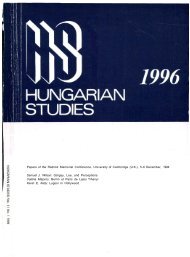The Canadian-American Review of Hungarian Studies - Vol. 4 ... - EPA
The Canadian-American Review of Hungarian Studies - Vol. 4 ... - EPA
The Canadian-American Review of Hungarian Studies - Vol. 4 ... - EPA
Create successful ePaper yourself
Turn your PDF publications into a flip-book with our unique Google optimized e-Paper software.
Carpathian Federation, and printed by the Dai Nippon Printing Companyin Hong Kong. A more truly international venturecould hardly beimagined. A careful reading <strong>of</strong> some <strong>of</strong> the articles leads to the suspicionthat Australian Carpathians are really Australo-<strong>Hungarian</strong>s(pardon the pun) in disguise. <strong>The</strong> term "Carpathian Basin", rather thanHungary, is used regularly in the text, <strong>of</strong>ten with the basic assumptionthat the basin would serve as the focal point <strong>of</strong> the integration movement.From an over-all perspective, the articles are uneven in quality andinterest. <strong>The</strong> translation <strong>of</strong> the Ermacora article is undoubtedly correct,but a bit stilted. Typographical errors are an occasional minor annoyance.While the book is intended to promote a political goal <strong>of</strong> sorts, most<strong>of</strong> the articles selected are neither political nor polemical in content.<strong>The</strong>y have been drawn from a wide variety <strong>of</strong> academic disciplines.Graphs and charts provide statistical information on population factors,natural resources and trade. One need not be an academicspecialist in order to pr<strong>of</strong>it from reading the work, although its primaryappeal will be to the Central and East European devotee.Indiana University <strong>of</strong> PennsylvaniaEdward E. PiattA Short History <strong>of</strong> Hungary. By Zoltan Haiasz. Translated by CsabaSzabo. Budapest: Corvina Press, 1975. Distributed by Imported PublicationsInc. <strong>of</strong> Chicago. 275 pp. Illustrations. $10.00 cloth.Tastefully turned out by Corvina, this historical primer presents andupdates for English-language readers the interpretation <strong>of</strong> Hungary'spast familiar to us from the work <strong>of</strong> the late, outstanding Marxisthistorian Erik Molnar. <strong>The</strong> translation is nearly flawless and idiomatic,though we hope that the rendering <strong>of</strong> the 1918 Karolyi dszirdzsdsforradalom as the "Michaelmas Daisy Revolution" will prove to be lessrisibility-inducing in Britain than in America.Structurally the book is disproportionate. <strong>The</strong> first fourteen centuries<strong>of</strong> <strong>Hungarian</strong> prehistory and history ending in 1900 receive 174pages; the ensuing seventy years, 87. More space is devoted to the 10th<strong>Hungarian</strong> Party Congress than to the Reformation, about the same asthe author gives to the Rakoczi and Kossuth Wars <strong>of</strong> Independenceeach. <strong>The</strong> illustrations are excellent but there are no maps. <strong>The</strong> translator'spractice <strong>of</strong> using <strong>Hungarian</strong> place names in discussing eventstaking place in territories detached from Hungary in 1918-1920 (Pozsony,Ersekujvar, Gyulafehervar, Balazsfalva, Vilagos, Liptoszent-
















